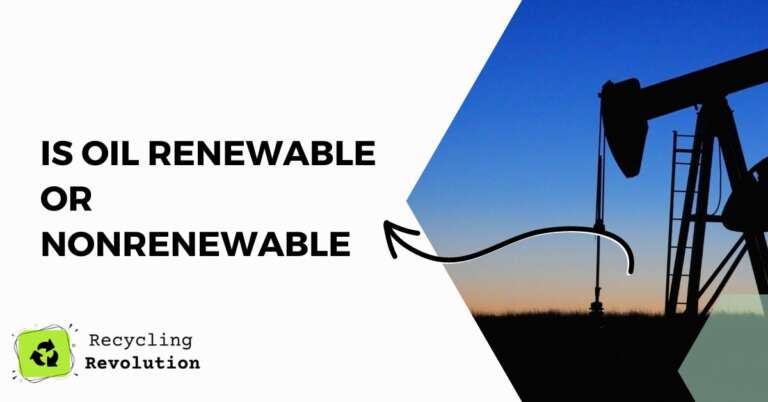Oil has been the lifeblood of our modern civilization, driving economies and shaping nations. But one question that often pops up in various circles is: Is oil renewable or nonrenewable? In this article, we’re going to embark on a deep dive into this subject. Stay with me, and I promise by the end, you’ll have a comprehensive understanding of this crucial topic.
tl;dr: Oil, as we commonly know it, is nonrenewable. It takes millions of years to form, and we’re using it at a much faster rate than it’s being produced.
What is Oil?
Let’s establish what we mean by “oil”. Predominantly, we’re discussing crude oil, a naturally occurring substance found beneath the Earth’s surface. It’s formed from ancient organic materials – think plants and tiny sea creatures – that have been subjected to heat and pressure over millions of years.
The Argument for Oil Being Nonrenewable
The most significant point here is the time factor. The process of oil formation isn’t something that occurs over a few years, decades, or even centuries.
The Geological Timescale: When we talk about oil formation, we’re venturing back into geological timescales. The oil we extract today began its journey over 300 million years ago during the Carboniferous Period. In such a timeframe, the word “renewable” starts to lose its meaning.
Rate of Consumption vs. Production: Here’s a bit of sobering data. The world consumes approximately 100 million barrels of oil per day. If we contrast that with how long it takes for oil to form, it’s clear we’re using it way faster than Mother Nature can produce it.
Finite Reserves: Multiple studies have shown that Earth has a finite amount of easily accessible oil. The U.S. Energy Information Administration (EIA) estimated in 2020 that there were 1.73 trillion barrels of technically recoverable oil left in the world. Sounds a lot? Given our current rate of consumption, that’s less than 50 years’ worth.
The Argument for Oil Being Renewable
Alright, let’s flip the coin. There’s a fringe theory out there that suggests oil might be renewable. How?
Abiogenic Petroleum Origin: This theory proposes that oil isn’t just from ancient organic matter but is formed from deep carbon deposits and tectonic activity. The evidence? Some oil wells that were once thought “depleted” have shown signs of refilling. However, these refilled quantities are minuscule compared to global demand.
But here’s where I chime in with my perspective: even if abiogenic processes do contribute some amount of oil, it’s nowhere near enough to consider oil as a truly renewable resource. The rate of any such replenishment would be dwarfed by our consumption.
Recommendations for the Future
Given the overwhelming evidence, I recommend a pragmatic approach:
- Diversify Energy Sources: It’s high time we ramp up investments in alternative energy sources. Solar, wind, and hydroelectric power should be at the forefront of our energy agenda.
- Drive Efficiency: In industries that still rely on oil, maximizing efficiency can make a big difference.
- Educate and Innovate: Encourage the next generation to understand the implications of oil dependence and to innovate in sustainable technologies.
The Environmental Impact of Oil Extraction and Usage
While we’ve touched on the renewability aspect of oil, it’s crucial to discuss the environmental consequences associated with its extraction and consumption.
Extraction’s Ecological Footprint: Oil drilling, whether it’s offshore or on land, disrupts local ecosystems. Spills, which are sadly not rare, can have devastating effects on marine life. Remember the Deepwater Horizon spill in 2010? It spilled approximately 4.9 million barrels of oil into the Gulf of Mexico, impacting countless marine species and coastal habitats.
Air Pollution and Health: When burned, oil releases pollutants that can degrade air quality. Cities with high vehicle traffic often grapple with smog, a harmful air pollutant. And it’s not just about the environment. Poor air quality from burning fossil fuels, including oil, is linked to respiratory diseases and can exacerbate conditions like asthma.
Carbon Footprint and Global Warming: This is a biggie. Oil combustion releases carbon dioxide (CO2), a primary greenhouse gas responsible for global warming. As of the last update, transportation alone accounted for about 29% of total U.S. greenhouse gas emissions, with the majority coming from gasoline combustion.
Peak Oil: A Looming Reality?
“Peak oil” is a term you might have heard floating around. It’s the point at which the extraction of oil reaches its maximum, after which it’s expected to enter terminal decline. Some experts believe we’ve already hit this peak, while others argue it’s on the horizon.
I recommend staying informed about peak oil discussions. The repercussions won’t just be environmental but also economic, affecting everything from transportation costs to food prices.
Transitioning to a Post-Oil Era
If oil is nonrenewable and has such significant environmental implications, what does a post-oil future look like?
Electrification of Transport: Electric vehicles (EVs) are rapidly gaining traction. With advancements in battery technology and infrastructure, EVs are set to play a pivotal role in reducing our oil dependence.
Biofuels: Derived from organic matter, biofuels are being explored as a potential substitute for fossil fuels. While they’re not without their challenges, they do present a more sustainable alternative.
Hydrogen: Touted by some as the fuel of the future, hydrogen can be used to power fuel cells in vehicles and industries. It has the advantage of emitting only water vapor when burned.
Circular Economy and Reduced Consumption: One of the fundamental ways to address our oil dependency is by reducing consumption. Adopting a circular economy, where we reuse and recycle more, can significantly cut down on oil demand, especially in industries like plastics.
Economic Implications
Lastly, we can’t discuss oil without touching on its economic impact. Oil prices can make or break economies, especially in countries heavily reliant on oil exports.
Global Economics: Fluctuations in oil prices can have ripple effects throughout global economies. Higher oil prices increase transportation costs, which can then result in price inflation for goods and services.
Jobs and Industry: The oil and gas sector is a major employer in several regions. Transitioning away from oil isn’t just an environmental consideration but also an economic and social one. Creating green jobs in renewable sectors is vital to ensure a smooth transition.
Note: The push away from oil is not just an environmental imperative but an economic strategy. A diversified energy portfolio can help nations weather the ups and downs of volatile oil markets.
In weaving through the intricate tapestry of oil’s role in our world, it’s evident that its implications are vast and multifaceted. While the renewability of oil is a closed case for most experts, the path forward requires a nuanced approach, balancing environmental concerns with economic realities.
Conclusion
To wrap things up, while there’s a romantic notion that oil might somehow be a never-ending resource, the reality is starkly different. Oil, in the way we understand and use it, is nonrenewable. Our planet has given us a finite gift, and it’s running out. It’s up to us to make the transition to more sustainable energy sources, and the clock is ticking.
FAQs:
How long does it take for oil to form?
It takes millions of years, often dating back to the Carboniferous Period, over 300 million years ago.
Are there any alternatives to oil?
Absolutely. Solar, wind, and hydroelectric power are just a few examples.
How much oil does the world use daily?
As of recent data, the world consumes around 100 million barrels of oil per day.
Note: The statistics and studies referenced above are based on data available up until 2021. Always refer to the latest research for the most up-to-date information.

